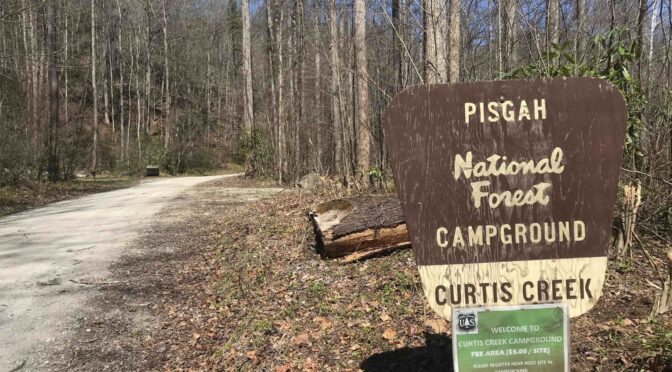We revisit this blog from a couple years back because it’s especially appropriate today, now that gathering in groups, outside, is a thing again. And frankly, gathering 20, 25 good friends for a weekend of camping and hiking is one of the best ways to reunite that we can think of.
We take a lot of groups on weekend hiking trips to the mountains. As a result, we stay in a lot of group campgrounds. When we book a group campground, we look at a number of factors, including:
- Proximity to good hiking. Ideally, we look for a campground with immediate access to trails — and not just any old trails, but trails that will yield a full day of memorable hiking. If we can treat people to an entire day of using just their own feet to get around, we find they enjoy the day that much more.
- Shaded camping. We group camp mostly in summer, so we need to pitch tents where they won’t broil during the day.
- A commons area. A big fire pit, a picnic table or two, rocks or logs to sit on — we don’t ask much, but these are biggies.
- Basic amenities. We need water at the campsite, we’d like a privy not too far away. A bathhouse, of course, is nice. And if we can park a reasonable distance away — within 50 yards of the campsite, say — all the better.
- Privacy. From others in the group, to some degree (hey, we all need a little me time), but mostly from neighboring campers. We escape to the wild for various reasons; it’s those who escape to the wild to be wild that we prefer to avoid.
- Good vibe. Most importantly, the site must have a good vibe. It needn’t be immaculately groomed; rather, we like a spot that fits in with the natural surroundings. Sometimes you know the second you drive up, sometimes it takes a night or two of camaraderie to summons that vibe.
There are other factors, but these are the basics. Based on these basics, here are our our five favorite group campgrounds in North Carolina.
Standing Indian Recreation Area
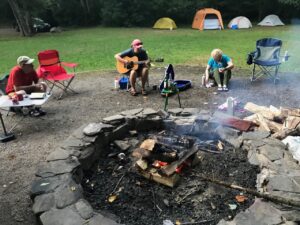
Nantahala National Forest, Franklin
No. of group sites: 3
Each site accommodates: 25 people
$83 per night
More info here.
The Standing Indian Recreation Area is a U-shaped bowl rimmed, for the most part, by the Appalachian Trail. From the bottom, several trails snake up and connect to the AT, making for all kinds of loop and near-loop options. The three Standing Indian group sites are located along Kimsey Creek; an eponymously named trail parallels the creek to Deep Gap and connects to the AT; from there, it’s about a mile to 5,499-foot Standing Indian Mountain and a grand view of the Georgia mountains beyond, before returning to camp via the Lower Ridge Trail. Boom! An 11-mile loop right out of camp. Then there’s Kimsey Creek itself: On our first visit, after doing the aforementioned 11-mile loop on a steamy August day, we returned mid-afternoon to camp; within 20 minutes, everyone was parked in the creek (with some hoisting adult refreshments). We stayed until the sun slipped beneath the basin’s western rim and the temperature began to quickly drop: by 8 o’clock, we were sporting fleece around the campfire, a campfire in a generous stone firepit. We love this trip so much that rather than our typical 3-day visit we’ve extended this year’s visit in mid-August to 4 days. (See below for details.)
North Mills River Recreation Area
Pisgah National Forest, southwest of Asheville
No. of group sites: 1
Accommodates: 30 people
$40 per night
More info here.
North Mills River was our Plan B the first time we visited. We’d intended to stay at the nearby Davidson River Campground outside Brevard, but the campground was booked when we went to make reservations. We got out a map, started searching nearby … and noticed North Mills River about 20 crow-fly miles to the northeast. We wanted to hike in the region, so we booked. We were rewarded upon arrival with a grass meadow perfect for Frisbee, rimmed by hardwoods ideal either for camping beneath, or for stringing a hammock between. A nice commons area with picnic tables and fire ring, and we couldn’t have been happier. Or so we thought. The next day we set out from camp and hiked up the river to the old Hendersonville Reservoir, then continued up old-growth-rimmed Fletcher Creek, with about a dozen creek crossings. Eventually, we took the Spencer Gap Trail up to the Blue Ridge Parkway on one of those classically challenging-yet-rewarding Pisgah hikes. The following day we did a similar hike, on different trail, up to the parkway. There’s a good week of hiking out of this campground
Briar Bottom Campground
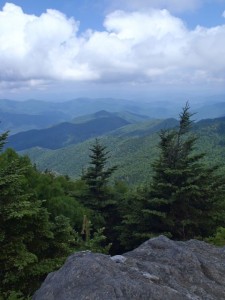
Pisgah National Forest, Burnesville
No. of group sites: 6
Each site accommodates: 50 people
$85 per night
More info here.
Basecamp for our annual Mount Mitchell adventure, this collection of six group sites sits at the base of the highest mountain east of the Black Hills, 6,684-foot Mount Mitchell — and there’s a trail you can catch right outside the campground that takes you 5.5 miles and 3,700 vertical feet to the summit. There are other hikes as well, and it’s only about a 30-minute drive to the top, where you can hike short nature trails or head out the rugged 13-mile Black Mountain Crest Trail, which spends much of its first few miles above 6,000 feet. At an elevation of 3,000 feet, the campground is blessed by cool nights for sleeping. Because of the number of sites and their capacities, large groups tend to flock here and take up multiple sites. Your best bet for a little privacy is the Ash camp site. If you like to fly fish, the South Toe River, known for its trout, is a short walk.
Cataloochee Group Campground
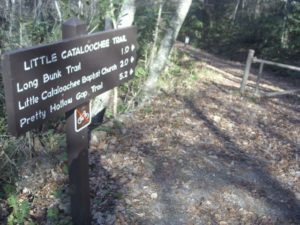
Great Smoky Mountains National Park, Cataloochee
Accommodates: 25 people
No. of sites: 3
$40 per night
More info here.
You get the distinct impression you’re in remote country on the windy gravel road that descends into the Cataloochee Valley from civilization. And you are, although that wasn’t always the case. Prior to the park’s creation, a town of 1,300 thrived in the valley, a town you can still see remnants of in the handful of preserved buildings you can tour in the south end of the valley. A popular evening activity is to walk from the campground into the valley as evening settles in and watch the elk heard emerge from the forest fringe to feed. Then hang out and watch the shadow rise on the valley’s east wall as the sun sets. Oh, and the hiking! Several shorter loops (shorter as in under 10 miles) can be created via trails on the south side of the valley. If you’re up for an epic, an 18-mile loop heading out on Little Cataloochee and Long Bunk trails takes you up to the boreal zone of Mount Sterling, then returns down Pretty Hollow Creek (trip No. 19, if you have a copy of “Backpacking North Carolina.”). Both options expose you to the restored buildings of Cataloochee.
Curtis Creek Campground*
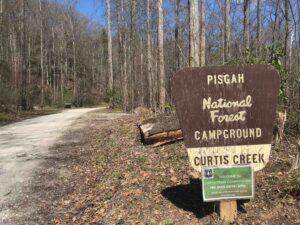 Pisgah National Forest, Old Fort
Pisgah National Forest, Old Fort
No. of sites: 25
Accommodates: 6 per site
$10 per night
More info here.
Let’s start with the asterisk: this isn’t actually a group campground. Rather, it’s 25 separate sites, but because of the low cost and the fact many of the sites are walk-ups (no reservations; first come, first camped), this is a good bet for the group that failed to plan ahead and reserve a bonafide group site. The campground is in a steep, narrow valley that leads from Old Fort up to the Blue Ridge Parkway. Trail from the campground climbs into old growth woods. For less challenging hiking drive up to the Parkway and either head south to Mount Mitchell or north to Crabtree Meadows. If you’re into mountain biking and getting a good workout, the campground is on the route of the 60-mile Off-Road Assault on Mountain Mitchell race, which includes some nice gravel road riding and some challenging singletrack.
Speaking of Curtis Creek …
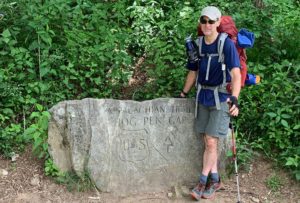
We’ve just announced our first GetHiking! Hiking Weekend of 2021! We’re starting out at Curtis Creek, the area where the Pisgah National Forest got its start back in 1918. The rugged terrain supports some of the oldest forest in the entire half-million-acre Pisgah, which we’ll explore on a pair of 8-mile hikes. This camping weekend is a chance to reunite with the mountains, reunite with fellow hikers after a long absence. Learn more and sign up here.
Speaking of speaking …
 Our latest GetHiking! Southeast Podcast dropped today, an interview with day hiker-turned-section hiker Henry Perangelo. Henry discusses the transition from weekend hiker to hiking for an extended period, as well as how to plan for a section hike. Give a listen here.
Our latest GetHiking! Southeast Podcast dropped today, an interview with day hiker-turned-section hiker Henry Perangelo. Henry discusses the transition from weekend hiker to hiking for an extended period, as well as how to plan for a section hike. Give a listen here.
